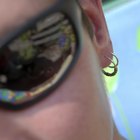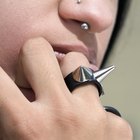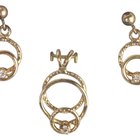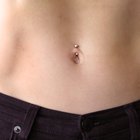
You can stretch an existing ear piercing into a large-diameter ear piercing. If you do not have pierced ears, you can pierce your ears at a large gauge. Typical ear piercings, from a piercing gun, are a small gauge, such as 20. Professional piercings, done with a sterile needle by a piercer, start as small as 18 gauge and can be pierced as large as 0 gauge.
Ear Piercing Consultation
You should have a consultation with a professional piercer before receiving an ear piercing. Ask the piercer to show you piercing jewelry at specific sizes, or gauges, so that you have a good understanding of the size of the piercing. If you are not interested in stretching your earlobes or getting a large-gauge piercing, the piercer will use 18-,16- or 14-gauge jewelry for your earlobes. Plugs, incorrectly referred to as "gauges," come in 14 gauge and larger. You can create the illusion of stretched ears with a piercing with earrings that have a 16-gauge post and larger-gauge disks that screw on and off of the post. It is important to note that workplaces and schools might not allow large-gauge ear piercings and that once the ears are pierced or stretched to a size like 0 gauge, the hole might never shrink.
Paperwork and Aftercare
Before the piercing, you must fill out paperwork concerning your medical history and the legal terms of receiving the ear piercing. After completing the paperwork, you often go to a piercing room, which gives you privacy during the procedure. Then the piercer explains how to clean your ear piercings. In case you don't remember the instructions, the piercer also gives you a set of printed aftercare instructions to take home.
Cleaning and Marking
The piercer, while wearing gloves, cleans both of your earlobes in preparation for marking where the piercings go. Tell the piercer if you plan to stretch your earlobes before the marking process. The piercer asks you to make some facial movements, such as smiling, to see if your ears move and to help with the marking. Your ears are not symmetrical, but the piercer considers your anatomy before marking the placement of the piercings. Even if one earlobe is higher or sticks out farther from your head, correctly placed earlobe piercings give the illusion of matching ear piercings. The piercer then marks your earlobes with a sterile marking pen and asks you to look in the mirror at the marks. If you have any issues with the placement, tell the piercer immediately.
The Piercing
For ear piercings up to 6 gauge, the piercer uses a sterile needle to pierce the earlobes. For large-gauge piercings, he uses a dermal punch. The piercer's technique determines the way the earlobe is pierced. If the piercer uses a needle receiving tube, he places the tube behind the ear. If he uses forceps, he places the tips of the forceps on each side of the ear. If he does the piercing freehand, he holds the top and side of the ear. Regardless of the method the piercer uses, you will feel slight pressure on and around your earlobes. The piercer will pierce your earlobes one at a time, inserting the plugs immediately following the piercing device.The piercer inserts the plug from the front of the earlobe and attaches an o-ring on the back to secure the jewelry in the ear.
After The Piercing
The earlobe piercing will bleed during and after the procedure. There might be a lot of bleeding with large-gauge piercings, and the piercer will apply pressure to the wound after the jewelry insertion and use sterile gauze and antimicrobial soap to clean the earlobes of blood. Ask the piercer any questions you have, and refrain from touching your ear piercings, not only in the piercing shop, but after you leave to keep bacteria from entering the fresh piercing.
Related Articles

How to Gauge the Ears Right After the ...

How Is Nipple Piercing Performed?

Places to Pierce Your Ear

How to Gauge Your Ears Without Tapers

How Long to Wait Before You Change a ...

How to Put in Double Flare Ear Plugs

How to Pierce Your Navel

How to Measure Your Earring Gauge Size

Information on Nose Piercings

Types of Piercing Needles

Taking Care of Gauged Ears

How Long After Piercing Can You Change ...

How to Remove a Labret Piercing

How to Open Pierced Ears That Have ...

How to Tell If Your Nose Piercing Closed

How Long Do I Have to Wait to Change My ...

How to Keep a Piercing From Rejecting

What If They Make a Mistake When ...

How to Remove a Navel Piercing

Professional Way to Clean an Eyebrow ...
References
Writer Bio
Maude Coffey retired after 10 years working as a professional body modification artist in the tattoo industry. She is certified in principles of infection control and blood-borne pathogens. Coffey received additional training and classes, such as anatomy, jewelry standards and aftercare, from the Association of Professional Piercers. Coffey aims to educate about safe tattooing and piercing practices while writing for various websites.
Photo Credits
Sexy tattoo man image by MAXFX from Fotolia.com